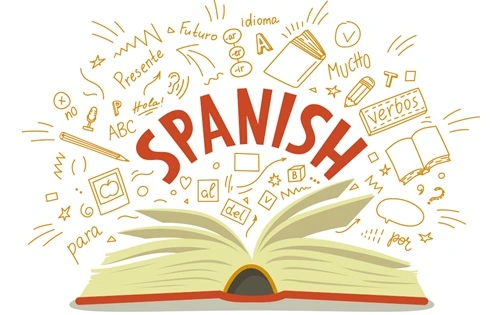The Spanish language, also known as Español or Castellano, is one of the most widely spoken languages in the world. With over 580 million speakers, it ranks as the second most spoken native language globally after Mandarin. Spanish has a rich cultural history and is the official language of 20 countries, primarily in Latin America and Spain. Its influence stretches far beyond the boundaries of these nations, shaping global culture, business, and education.
In this article, we explore 10+ interesting facts about the Spanish language that highlight its global significance, rich history, and linguistic uniqueness.

1. Second Most Spoken Native Language in the World
Spanish holds the position of the second most spoken native language in the world, with over 480 million people using it as their first language. It is spoken widely in Spain, Latin America (except Brazil), parts of the United States, and many other regions across the globe. Spanish is also one of the six official languages of the United Nations and is used extensively in international diplomacy and business.
2. A Global Language
Spanish is not just a language spoken in Spain and Latin America; it has truly become a global language. Spanish is the official language of 20 countries, including Mexico, Colombia, Argentina, and Spain, among others. It is also spoken in regions like the United States, where there is a growing Spanish-speaking population, and in countries like the Philippines, which retains a significant number of Spanish loanwords due to its colonial history.
Spanish has become the third most used language on the internet, following English and Chinese, reflecting its growing global presence in the digital age.
3. The Origin of Spanish
Spanish originated from Vulgar Latin, the spoken form of Latin used in the Roman Empire. It evolved in the Iberian Peninsula after the fall of the Roman Empire, around the 5th century. Modern Spanish, or Castilian, emerged in the region of Castilla (hence the name Castellano) and gradually spread across the rest of Spain. By the 16th century, with the exploration and colonisation of the Americas, Spanish began to spread to the New World, becoming a global language.
4. Influence of Arabic on Spanish
One of the most fascinating aspects of the Spanish language is the profound influence of Arabic. When the Moors ruled parts of Spain for nearly 800 years, between the 8th and 15th centuries, they left a significant mark on the language. It is estimated that nearly 4,000 Spanish words are of Arabic origin. Many of these words start with “al-“, such as:
- Almohada (pillow),
- Algebra (algebra),
- Alcohol (alcohol), and
- Alcázar (castle).
This linguistic influence also extends to place names and everyday expressions in the language, showcasing the deep historical ties between Arabic and Spanish.
5. Varieties of Spanish: Dialects and Accents
Spanish is spoken across many countries, and naturally, it has developed several dialects and regional accents. Some of the major varieties include:
- Castilian Spanish: The standard form spoken in Spain.
- Mexican Spanish: The most widely spoken variety due to Mexico’s large population.
- Argentinian Spanish (Rioplatense): Known for its distinct pronunciation of “ll” and “y” as “sh”.
- Caribbean Spanish: Spoken in countries like Cuba, Puerto Rico, and the Dominican Republic, with a faster, more rhythmic flow.
Despite these differences, all Spanish speakers can generally understand each other, but some regional expressions or slang might differ significantly.
6. Phonetic Language
One of the reasons that Spanish is often considered easier to learn for non-native speakers is that it is a phonetic language. This means that words are pronounced exactly as they are written, with very few exceptions. Once you learn the basic rules of pronunciation, it becomes easier to read and speak Spanish fluently.
For example, in Spanish, the letter “a” is always pronounced the same way, unlike in English, where vowels can have multiple pronunciations. This consistency helps learners gain confidence quickly in reading and speaking the language.
7. Gendered Nouns
Like many Romance languages, Spanish uses gendered nouns. Every noun in Spanish is either masculine or feminine, and the article and adjective that accompany the noun must agree in gender. For instance:
- Masculine: el libro (the book),
- Feminine: la casa (the house).
There are some general rules for identifying gender, but there are exceptions, making it one of the trickier aspects for language learners.
8. Verb Conjugation: A Challenge for Learners
Spanish verb conjugation can be complex, especially for those new to the language. There are three main verb endings: -ar, -er, and -ir, and each of these has different conjugation patterns. Spanish verbs are also conjugated according to tense, mood, and subject, which means a single verb can have many forms. For example, the verb “hablar” (to speak) changes to:
- Yo hablo (I speak),
- Tú hablas (You speak),
- Él/Ella habla (He/She speaks).
While challenging, mastering verb conjugation is essential for effective communication in Spanish.
9. Spanish Influence on English
Due to historical interactions and cultural exchanges, Spanish has influenced the English language as well. Many words in English have been borrowed from Spanish, especially in regions like the United States, where Spanish and English coexist. Common words borrowed from Spanish include:
- Canyon,
- Patio,
- Fiesta,
- Tornado,
- Hurricane.
The influence of Spanish on American English is particularly strong in states like California, Texas, and Florida, where Spanish-speaking communities have been present for centuries.
10. Spanish and Literature: The Language of Great Writers
Spanish is the language of some of the world’s most influential literary figures. Miguel de Cervantes, considered one of the greatest writers of all time, wrote “Don Quixote” in Spanish. This novel is one of the most translated and widely read books in the world, and Cervantes’ work had a profound impact on literature globally.
Other notable Spanish-speaking writers include Gabriel García Márquez (Colombia), who won the Nobel Prize for Literature for his masterpiece “One Hundred Years of Solitude”, and Pablo Neruda (Chile), known for his passionate poetry.
Spanish literature is celebrated for its depth, creativity, and influence, and it continues to inspire writers and readers worldwide.
11. Spanish is a Fast-Spoken Language
Studies have shown that Spanish is one of the fastest spoken languages in the world in terms of syllables per second. Spanish speakers tend to speak at a rapid pace, which can be challenging for learners to follow in real-time conversations. However, this speed is counterbalanced by the relatively straightforward pronunciation, making it easier to comprehend with practice.
12. The Spanish Royal Academy
The Real Academia Española (RAE), or the Spanish Royal Academy, plays a crucial role in regulating and preserving the Spanish language. Established in 1713, its motto is “Limpia, fija y da esplendor” (It cleans, fixes, and gives splendour). The academy oversees the language’s development, creates dictionaries, and ensures that Spanish remains consistent across the many countries where it is spoken.
The RAE also collaborates with language academies in other Spanish-speaking countries to ensure the language evolves uniformly while respecting regional differences.
13. Spanish and the Digital World
Spanish is one of the fastest-growing languages on the internet, and its digital presence is expanding rapidly. From social media to online education, Spanish-speaking users form a significant part of the global online community. Many international websites, apps, and services offer Spanish as one of their primary languages, further cementing its importance in the digital age.
In recent years, Spanish-language content on platforms like YouTube and TikTok has seen a sharp rise, with creators from Spanish-speaking countries gaining global audiences.
Conclusion
The Spanish language, with its rich history, widespread use, and cultural impact, is a fascinating subject of study. From its roots in Vulgar Latin to its global dominance today, Spanish continues to evolve while maintaining its essence. Whether you’re learning it for business, travel, or personal enrichment, Spanish opens doors to a world of opportunity, connecting you to millions of speakers across the globe. Its influence on literature, art, culture, and even technology shows that Spanish is not just a language but a vital part of the world’s heritage.


